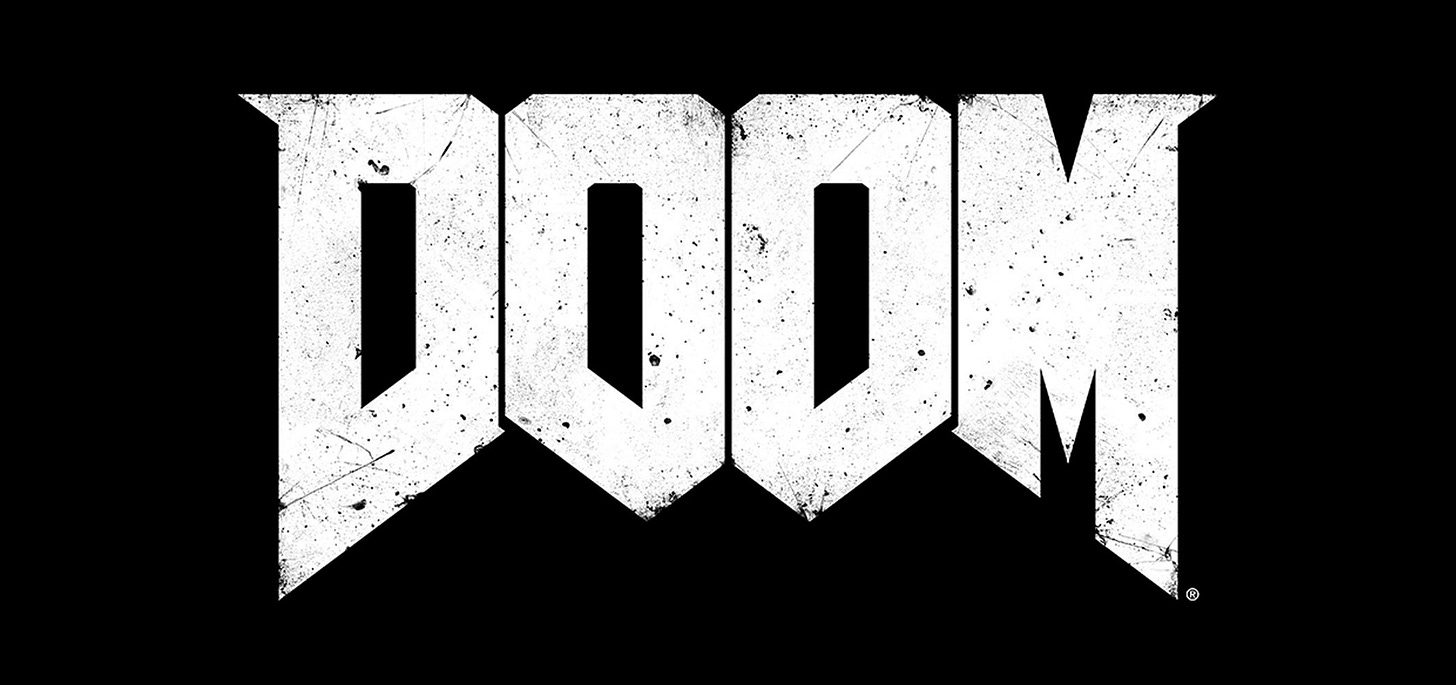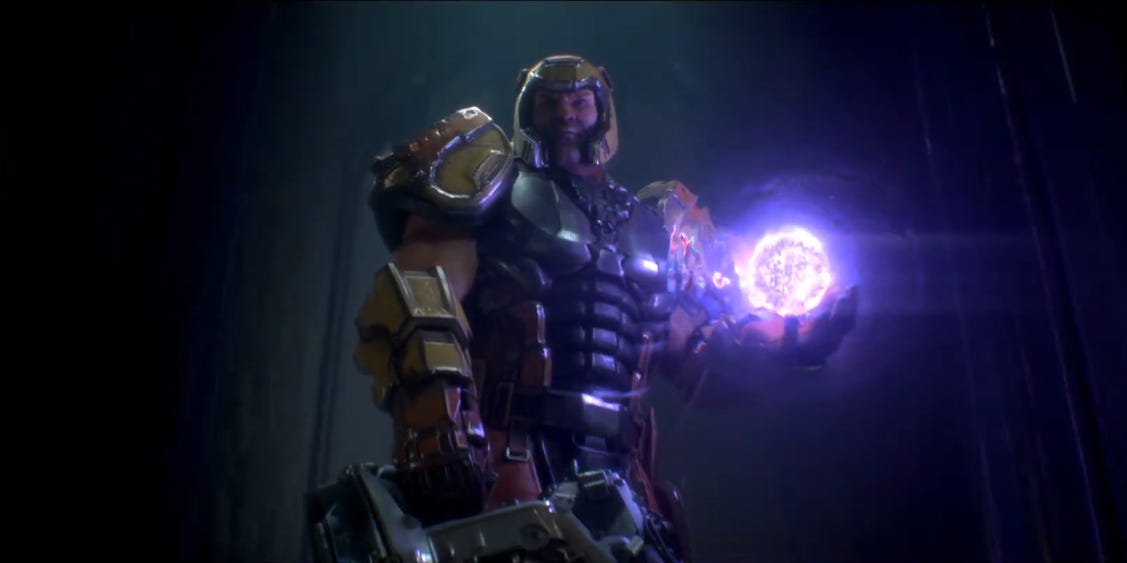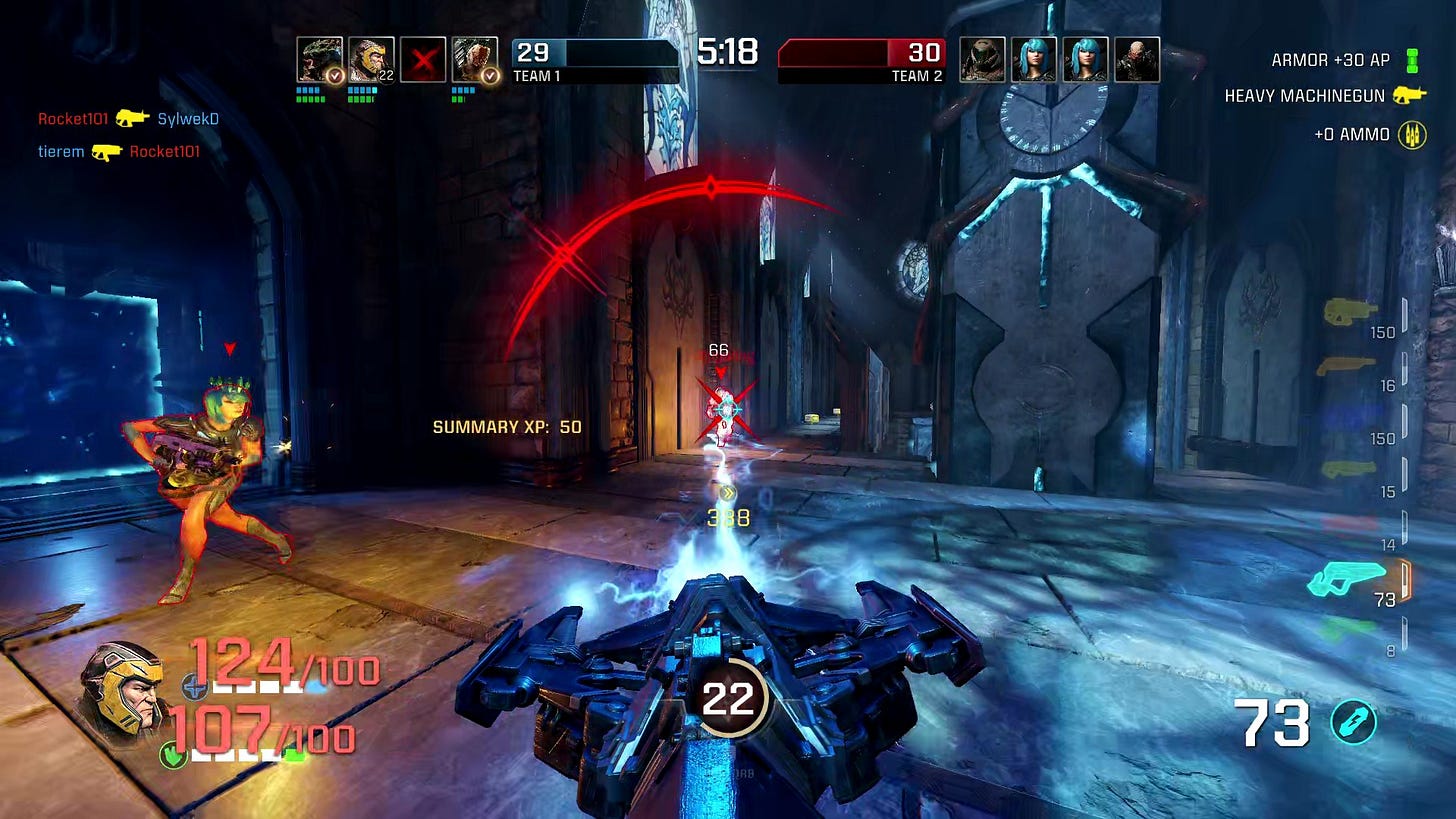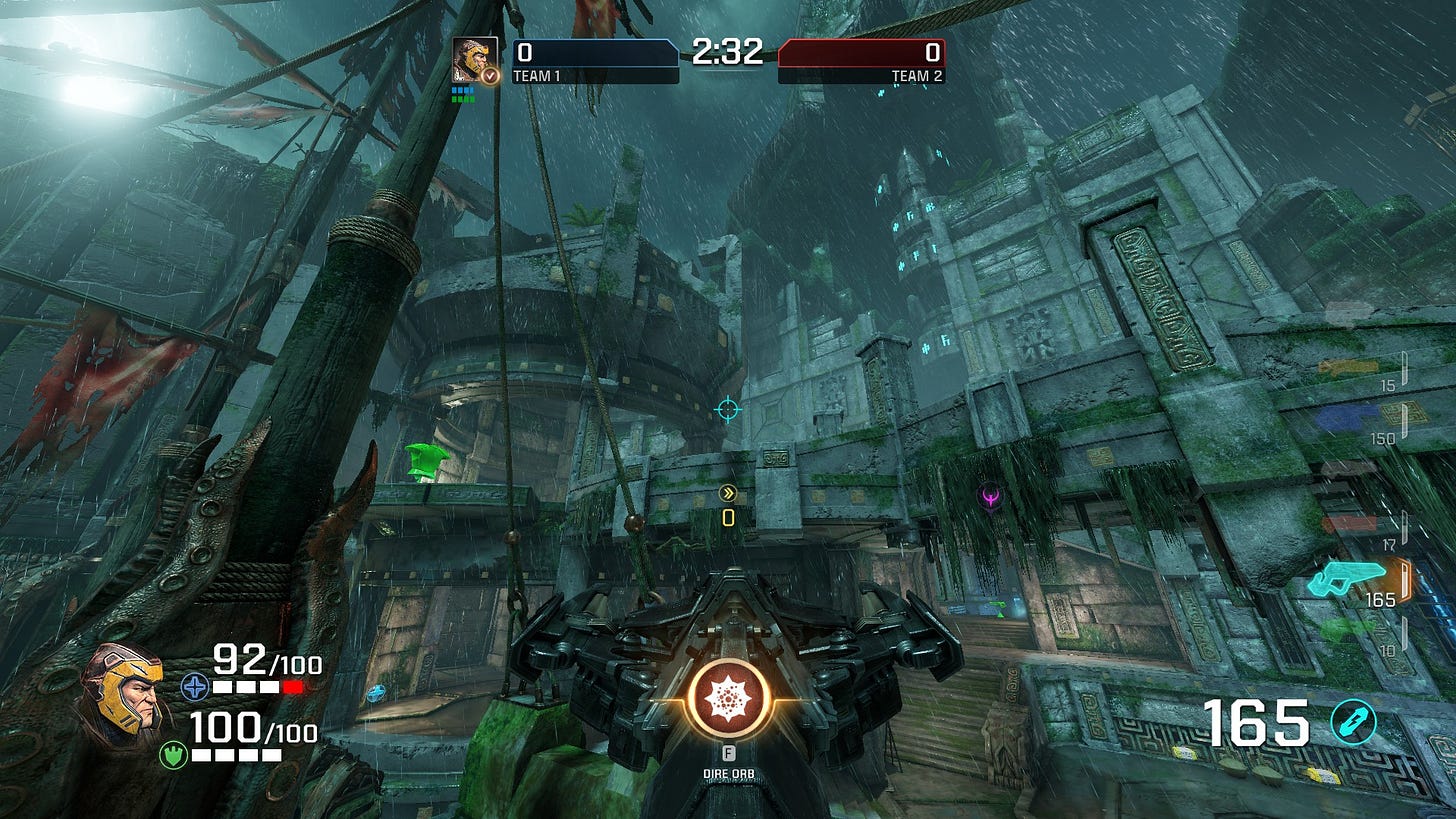Welcome to Episode Seven of “Quake’s Bizarre, Beautiful History!” Read the previous episodes here:
Though Quake and its kin had been pushed out of the spotlight by the more realistic and varied shooters of the 2000s, enough time had passed that the fickle consumer was starting to grow bored of them, too. In line with the rest of the industry, shooter campaigns had become increasingly linear and hand-holding, leaving little room for exploration, challenge, or intense gunplay. With many greats like Half-Life, Halo, and Bioshock becoming things of the past and Call of Duty and Battlefield growing more formulaic every year, the landscape for shooter games was looking just plain boring. By now, we knew how to tell stories and craft interesting worlds in this genre, and the nostalgia train was making its way back to the ‘90s. The time was right once again for speed, for action, for unfettered violence with all manner of firearm.
And just as it had ushered the genre in before, the one to light the fire of this renaissance was…

On May 13th, 2016, Doom was back - for real this time. It went back to basics in all the best ways: quick movement, smooth shooting, no reloading, and big levels filled with vicious demons and collectibles. The new glory kill system let you deliver vicious finishers and rewarded you with health pickups for staying in the fight. New weapon mods and upgrades made exploration more rewarding and helped every weapon dish out even more pain. It was fast, it was brutal, and it was just the shot in the arm the genre needed. It had all the action and fun of the classics without feeling dated in the least, and it would go on to inspire many others to return to this classic sensibility. Games like Doom and Quake weren’t seen as immature relics of a primitive technological age anymore; they were “boomer shooters,” a subgenre all about running and gunning unshackled by petty realism.
Doom was back, and so was Wolfenstein too, thanks to MachineGames’ 2014 reboot Wolfenstein: The New Order (which is a story-driven action shooter with only some boomer shooter elements, but no less excellent for it - I’ll have to write about it eventually). It only makes sense now that Quake would follow suit, and id saw it as an opportunity to bring the boomer shooter renaissance back into the multiplayer space. After all, Quake had always been best known for its multiplayer, and free-to-play shooters were becoming a massive market. The iron was hot, and it was time for Quake to strike with its best foot forward - but even when you’re really trying your best, sometimes you still stumble.
Between Two Worlds

A Quake revival after Doom (2016) seemed like a lay-up, but there were some unique challenges facing the multiplayer-only concept. Boomer shooters were a lot more popular by now in single-player form since lesser-skilled players tend to get left in the dust in multiplayer. Quake’s distinctive game design compounded this problem, especially since it had been out of vogue so long that most of the younger generation of players weren’t going to understand its unintuitive quirks. On the flipside, the small but dedicated existing Quake community had grown to be very particular about what Quake should be. There was to be no compromise upon the speed, the weapon hierarchy, or the emphasis on map strategy, even if it was hard to learn. I can’t blame them for getting defensive about defining Quake, especially after games like Quake 4 and Enemy Territory: Quake Wars ignored the franchise’s unique appeal, but it was also true that Quake was going to have a hard time breaking back into the mainstream if it didn’t make an effort to be more approachable. On top of all of this, the landscape for multiplayer-exclusive games had become more competitive than ever; if it couldn’t succeed fast, it wouldn’t succeed at all.
Bridging the gap between legacy purists and casual newcomers wasn’t going to be easy, but this new Quake had to do it. Revealed at E3 2016, Quake Champions would showcase its solution: the champions. With the new hero shooter Overwatch emerging as a breakout hit the same year as Doom (2016), id thought to take a page out of its book and replace the cosmetic-only player models with distinct characters with a few unique abilities. Though loadouts don’t work in Quake’s system, players like having some control over their playstyle. Champions would have some minor passive abilities - usually granting new or easier movement methods - and more powerful active abilities which worked on a cooldown. Champions wouldn’t be as distinct or complex as they are in other class-based shooters, and Quake Champions’ modes wouldn’t put an emphasis on teamplay like Overwatch. The gameplay was fundamentally still Quake, but with some new tricks thrown in to keep the experience fresh.
There were some other minor changes meant to further refine the experience from Quake Live. Instead of everyone starting with the weak machine gun, players would have a choice between the machine gun, shotgun, or nailgun (nailguns standing in for the plasma gun this time around) at the start. These weapons all had “super” versions (or a “heavy” version in the case of the machine gun… not that the name really matters) available on the maps, so you got a little more control over your playstyle right out of spawn without infringing much on the intended value of hunting down better weapons. Armor and health pickups were also streamlined, with armor no longer being color-coded and instead simply categorized as either normal or “mega” just like health. Though small changes, they do help to streamline the experience a little bit, and that was the goal. The marketing for Champions focused a lot on the competitive side, too, with id sponsoring its own Quake Pro League for the game for years after launch. Producer Tim Willits was adamant that this game would finally get people off of the aging Quake Live with its own exciting scene.
Finally, there was the style. After years of messing around with the strogg, id made the smart decision to finally return to the first game’s highly-distinctive eldritch trappings. All of the maps - even returning ones which used to look more industrial - now consist of gothic fortresses and gnarled ruins filled with statues and stained-glass dedicated to cosmic deities. Each map belongs to one of the four dimensions from the original Quake, each lorded over by their own elder god. This is also why the game returned to the nailguns, even though they’re functionally identical to Quake Live’s plasma gun. The game contains a frankly unprecedented amount of lore scrolls for each champion, elder god, and more. They’re written better than you expect, too; this game fleshes Ranger out into a real character, attaches compelling lore to its elder gods and other champions, and functions as a collection of eldritch horror short stories on the side. With a focus on the fundamentals, some new features that would make the game more varied for casual players, and a return to the franchise’s most iconic theme, Quake Champions seemed like it had everything it needed to succeed.
Champion’s Tragedy

Fundamentally, Quake Champions feels just like it should. The maps look great and play just as well. The classic arsenal feels as good to shoot with as always even outside of the unholy trinity, with weapons like the super shotgun and heavy machine gun having more use than they did before. At a basic level, it feels just that little bit more refined and modern than Quake III: Arena. Unfortunately, the game stumbled in a few crucial areas. Instead of leveraging the excellent technology of idTech 6, the engine which made Doom (2016) good-looking, smooth, and easy to run on a variety of machines, Quake Champions bizarrely functions on a hybrid between Saber interactive’s Saber3D Engine and idTech. This hybrid made the game a lot more difficult to run than most other multiplayer shooters with similar visual fidelity and occasionally led to some occasional jank like rockets failing to collide with the floor or dodgy hit detection. As a result the game just ended up having an understandably taped-together feel at times.
It also launched in a weird, transitional time for multiplayer shooter structure. Though Overwatch had become a hit even with its $40 price tag, free-to-play was becoming the new norm in the market, and with it an unfathomable amount of in-game monetization to capitalize on the benefits of both large communities and irresponsible spenders. Quake Champions was purchasable as a complete package, but also had a free-to-play version where the classic Ranger was the only unlocked champion and others could be purchased or used during trial periods. It launched with a loot box system like Overwatch, letting players earn random rolls for new cosmetics by playing or by purchasing. Eventually, after Fortnite Battle Royale managed to eclipse Overwatch’s popularity the following year, Champions would follow suit by adding a battle pass on top of the mostly dummied-out lootboxes. This game contains a frankly stupid amount of cosmetics, with every champion having skins composed of head, body, waist, and leg sections and most skins containing further accessories per section. Don’t even get me started on the ridiculous amount of gaudy shaders you can use to retexture everything.
Even though they threw every monetization scheme in the book at this game, id forgot to properly build an audience willing to spend on it. Though champions were meant to appeal to casual players, almost nothing else about the game did. Aside from some lazy text guides in the game, it makes no effort to introduce Quake’s intricacies to new players. There is no playable tutorial for strafe-jumping or any intuitive introduction to map control or the weapon dynamics. The variety of game modes was also fairly bare-bones. Although non-deathmatch modes like capture the flag or the new sacrifice mode were fun, it was clear all of the maps were made primarily with duel in mind. Without less serious modes or a selection of larger, more open maps better-suited to team-based and casual modes, the game’s structure didn’t appeal to casual players.
What’s more, champions didn’t end up fitting into the system as well as id might have hoped. They have different maximum health and armor values to compensate for their size or mobility, further diminishing the even footing that has defined Quake for years. Many active abilities were too powerful early in the game’s life, with Ranger’s dire orb even allowing players to telefrag (teleport inside of and kill) players regardless of their health and armor. Although some passive abilities were smart accessibility features, like Nyx’s bunny-hopping which was slower, but easier than strafe jumping, many of them were instead hardly impactful. After many nerfs to active abilities, champions feel like a superfluous part of the game that only succeed at annoying purists. It basically just ends up being basic Quake gameplay except every so often your foe turns invisible before you can kill them or spits a bunch of acid in your face so you can’t see.
Quake Champions’ failures to expand its scope were laid bare by a disastrous streamer partnership event around the game’s launch on August 22nd, 2017. Major FPS streamers like Shroud, much more accustomed to modern styles of shooter, failed to understand what was supposed to be appealing about Quake just by jumping into Champions matches. Instead of being shown how Quake’s satisfying flow can come together for an awesome, action-packed experience, their impressionable audiences decided the game was just confusing and weird. Purists and major competitive Quake players were also vocal about the problems with champion balancing and many bugs, and the designs meant to bridge the gap between new and old players just ended up alienating both. Though the game continues to receive support from some kind of skeleton crew, its multiple monetization revamps and balance updates weren’t enough to save it from its fate, and it’s lucky to pass 350 active players worldwide at any time.
“Dead Game”

So Quake Champions fell flat again, and frankly, it deserved to at first. id didn’t have a good sense of how to build an audience in a market where other companies have gotten it down to a science, and they made a lot of unforced errors with the champion design and game engine. For all of its mistakes, though, I still think Quake Champions is so much better than it seems. Playing it years after launch, there’s little in the way of the Quake fundamentals and they feel great. The maps really do look amazing, and their atmosphere is only bolstered by awesome music from both Andrew Hulshult, a veteran of composition for boomer shooters, and Chris Vrenna, former Nine Inch Nails drummer. It’s one of the only shooters from the past decade I can think of which backs its matches with music, and it’s damn good music, too. When you take the lead, the music gets a big boost, making you feel even cooler than you already did.
I had a lot to say about the Quake flow in my Quake III: Arena article, but the truth is that I learned all that stuff in Champions. The awesome weapons, the smooth movement, and the great maps are alive and well in Champions and debatably even better than ever. Even some champions are pretty cool; Ranger nods to Quake’s final boss with his Dire Orb active ability (now no longer absurd) and takes reduced self-damage as a reference to being the star of the game that invented rocket jumping. Even with so few active players, I could still find good matches that tested my skills and pumped me up. What Champions tells us, though, is that it’s just not enough in this current multiplayer landscape to make a game that’s fun. All the most successful multiplayer shooters are engineered to be approachable and social, things that Quake historically hasn’t been.
Even with the bad first impression, updates have improved this game and renewed effort from id could have saved it. However, it was pretty clear that id thought this was a secondary project from the start and saw no value in seriously trying to salvage it. Quake by now had failed again and again; even though Champions learned some valuable lessons, bad luck and subpar execution made a good concept seem like something that just couldn’t succeed today. Quake wasn’t going to let itself be defeated, though. From development hell to an accidental sequel to a changing market, it has held on to life in some form through all manner of hardship. The simple reason why? It’s a game so exciting and unique that it deserves to live. It just needs someone willing to do it right; luckily, it may have found it.
Despite everything, Quake lives on! Experience the passion of its most dedicated fans and the potential it still contains in the exciting conclusion: “Dimension of the Future!” Coming soon!




